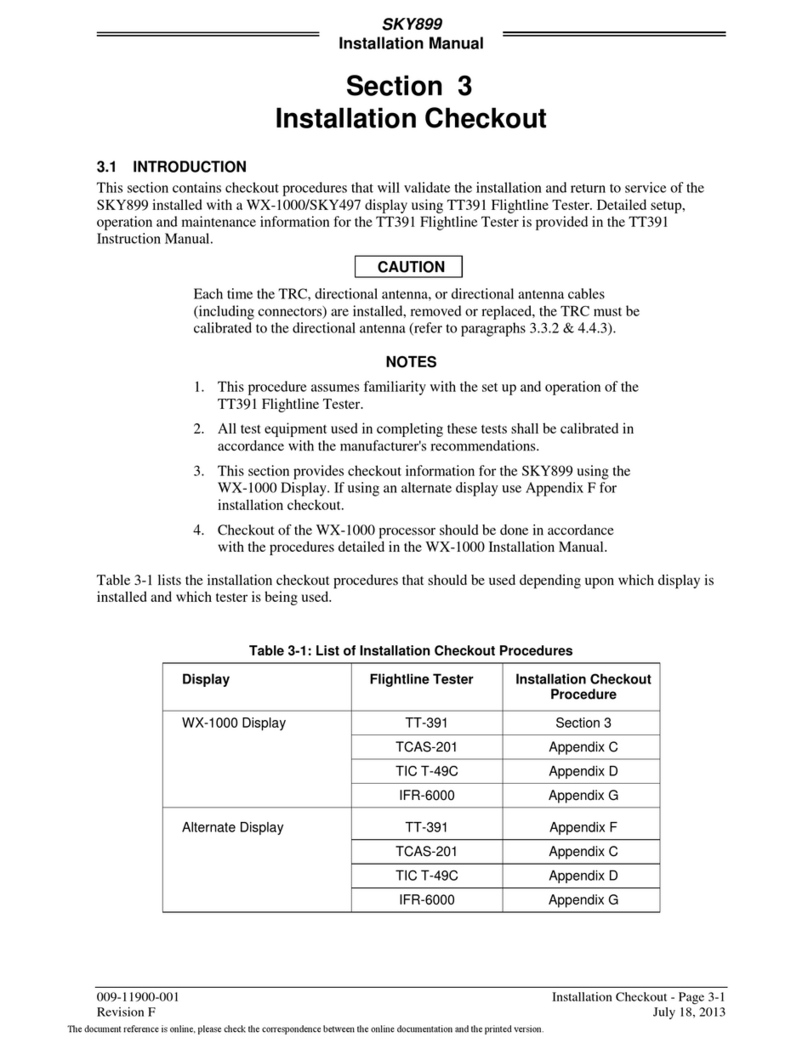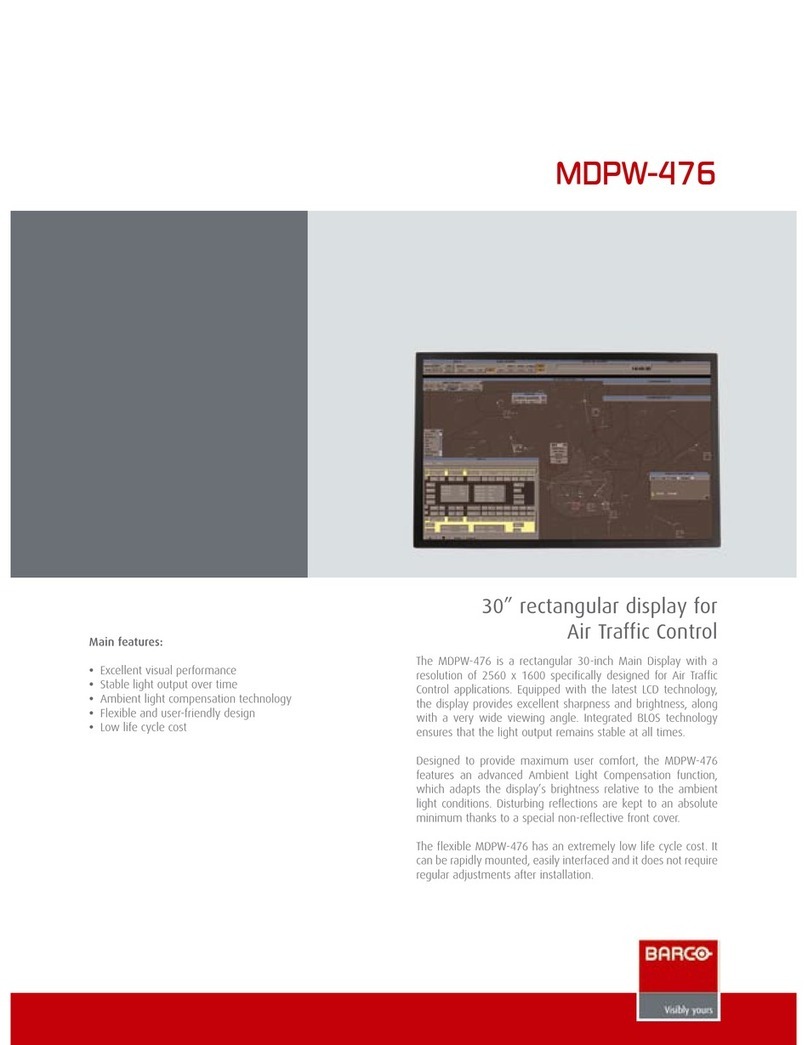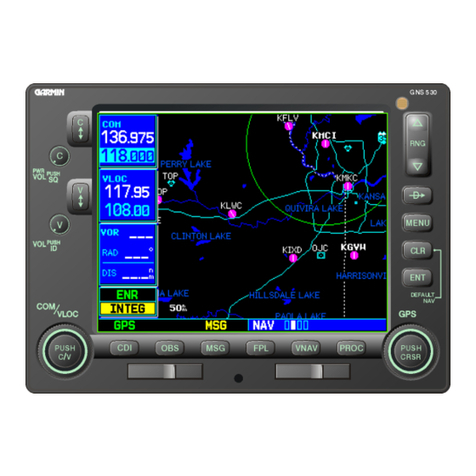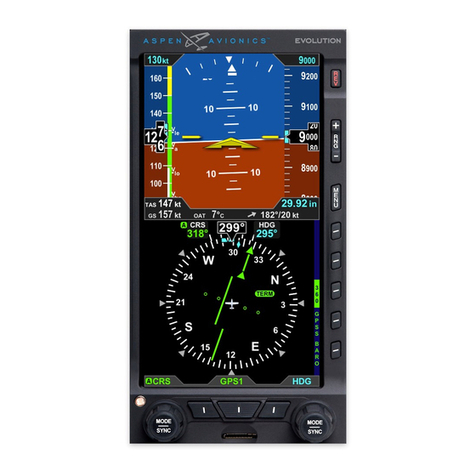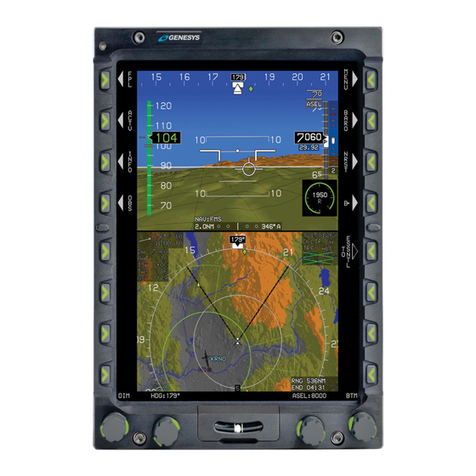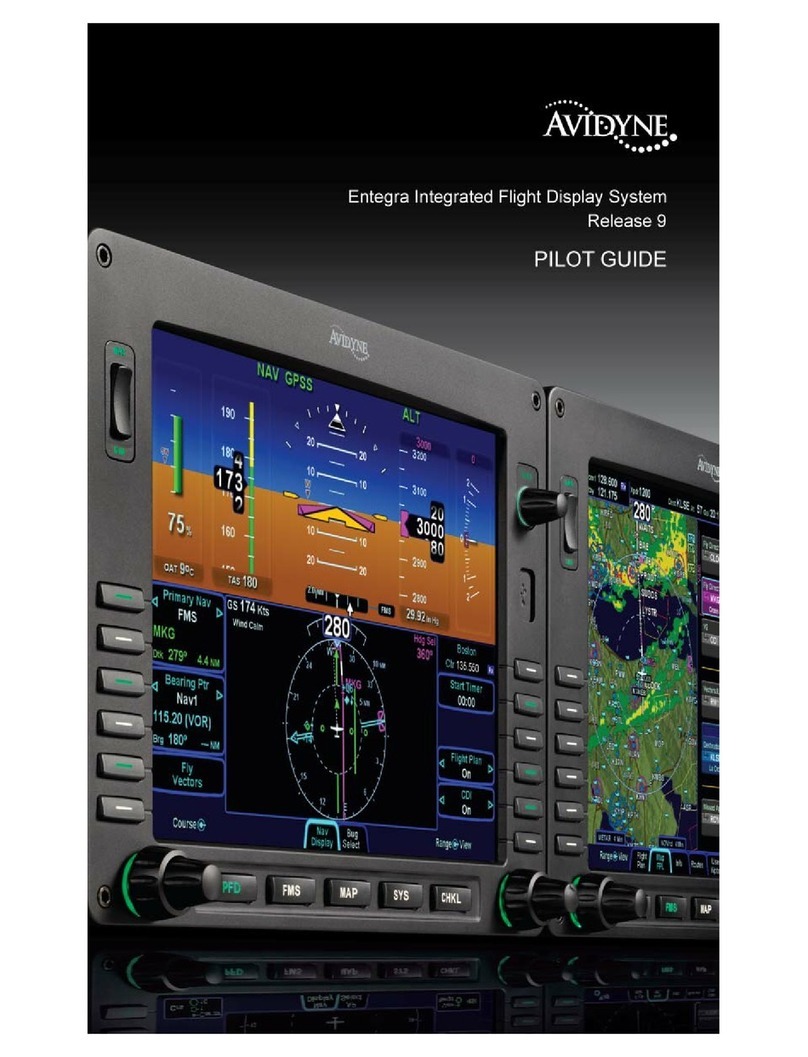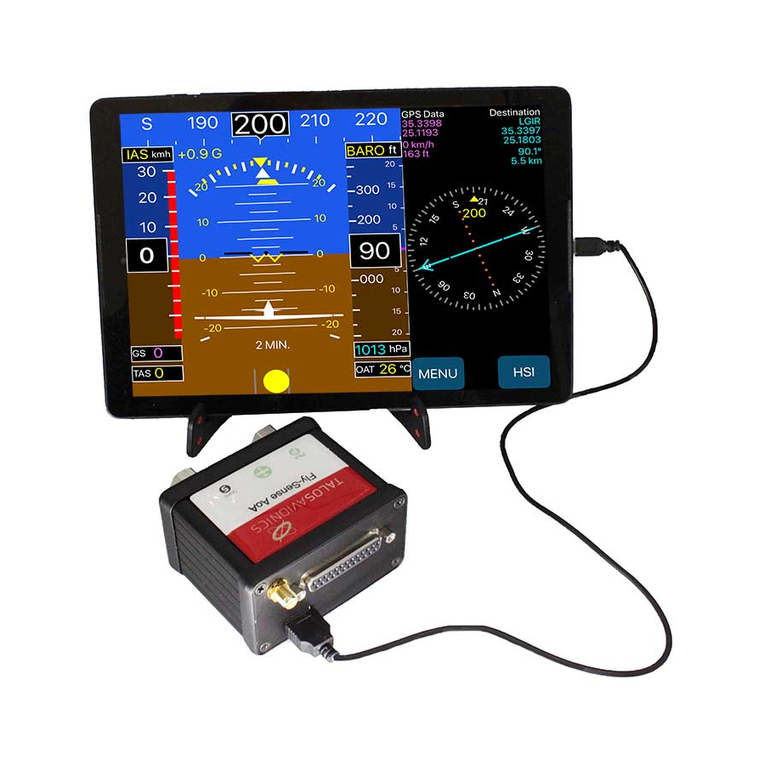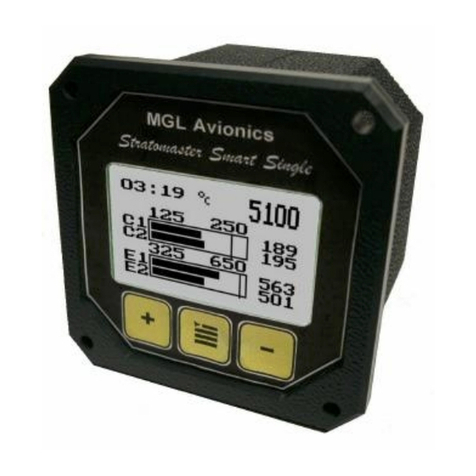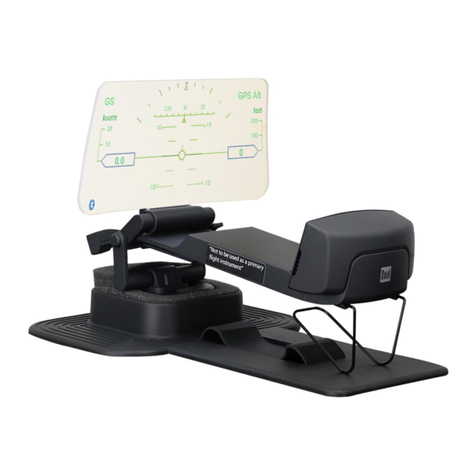Skywatch SKY497 Manual

Traffic Advisory System
Model SKY497
Pilot’s Guide
for the

SKY497 Pilot’s Guide
A
Export Notice
This data is provided at no charge, or at cost, to the public
and is considered publicly available, NoLicense Required
(NLR) as defined in the Export Administration Regulations
(EAR) Part 734.7-11.
Important Notice
This guide provides general information about the operation of
the SKY497. This guide does not cover all possible interconnec-
tions with all possible types and numbers of alternate displays
and customer-supplied switches. Refer to your aircraft flight
manual and flight manual supplement for information specific
to your aircraft. If there is conflicting information between those
manuals and this pilot’s guide, your aircraft flight manual and
flight manual supplement take precedence over this pilot’s guide.

Traffic Advisory System
Pilot’s Guide
for the
Model SKY497
© Copyright 1997, 2000, 2003, 2004
L-3 Communications Avionics Systems, Inc.
SKYWATCH
®
, EYES THAT NEVER BLINK
™
, Stormscope
®
, and i-linc
™
are trademarks of
L-3 Communications Avionics Systems, Inc.; Skydrol
®
is a registered trademark of Solutia, Inc.
The white
L3
in a circle design logo is a trademark of
L-3 C
ommunications
C
orporation.
Designed and manufactured in the United States of America by
Methods and apparatus disclosed and described herein have been developed solely on company funds of L-3
Communications Avionics Systems, Inc. No government or other contractual support or relationship what-
soever has existed which in any way affects or mitigates proprietary rights of L-3 Communications Avionics
Systems, Inc. in these developments. Methods and apparatus disclosed herein may be subject to U.S. Patents
existing or applied for. L-3 Communications Avionics Systems, Inc. reserves the right to add, improve, modify,
or withdraw functions, design modifications, or products at any time without notice.
L-3 Communications Avionics Systems, Inc.
5353 52nd Street, S.E.
Grand Rapids, MI 49512 USA
(800)253-9525 or (616)949-6600
Fax (616)285-4224
www.L-3com.com/as

ii SKY497 Pilot’s Guide
Eyes That Never Blink™
Early Traffic Alert/Advisory Systems
In the early days of flight, pilots were equipped with all they
needed for effective collision avoidance–a sharp pair of eyes.
But increasing traffic at higher speeds led to the development
of TCAS I and II (Traffic Alert and Collision Avoidance Systems)
which were too expensive for most regional airlines, business
aircraft, and general aviation aircraft.
SKYWATCH®
L-3 Avionics Systems recognized the need for an alternative to
expensive TCAS systems and developed the SKYWATCH model
SKY497 Traffic Advisory System (TAS).
The SKY497 provides most of the capabilities of TCAS I, but at
a significantly lower cost making it practical for small aircraft.
In addition, the SKY497 can share the display that comes with
the Stormscope®model WX-1000 so there’s no need to buy
another display if you already own a WX-1000 display (part
number 78-8060-5900-8). The SKY497 can also display its traffic
information on a growing number of multi-function displays
from companies such as Avidyne, UPSAT, L-3 (i-linc™MFD),
Garmin, and Collins. You can even display SKYWATCH traffic
information on a compatible weather radar indicator via the L-3
Avionics Systems Radar Graphics Computer.
Proven Experience
L-3 Avionics Systems has been involved in the development of
collision warning programs since the early 1980’s. In 1985, L-3
Avionics Systems began development of an enhanced collision
warning system for the Navy’s T-34C training aircraft.
Based largely on the success of the Navy project, L-3 Avionics
Systems was selected to validate the specifications for TCAS I.
As a result, L-3 Avionics Systems’ original TCAS I unit, the
TCAS791 was the first TCAS I to be granted a Technical Stan-
dard Order (TSO), first to receive a full, unrestricted Supple-
mental Type Certificate (STC), first to fly, and first to be delivered.

Safety Summary
These warnings and cautions appear later in this guide and are
repeated here for emphasis:
To avoid power surges that could damage the SKY497 and the
optional WX-1000, start your engines before turning on the SKY497.
If the SKY497 is in SKYWATCH mode, the display will not automati-
cally switch into Stormscope mode to display thunderstorms or
Stormscope errors. Use the remote SKYWATCH/Stormscope mode
switch to periodically check for thunderstorms or Stormscope errors.
The SKY497 relies on information obtained from transponders in
nearby aircraft. The SKY497 does not detect or track aircraft which
are not equipped with an operating Air Traffic Control Radar
Beacon System (ATCRBS) transponder.
The SKY497 does not track intruder aircraft approaching at a
closure rate greater than 900 knots.
Some traffic within the chosen display range may not be displayed
due to traffic prioritizing, antenna shielding, ground intruder
filtering, or surveillance range being shorter than the chosen
display range.
Optimum SKY497 performance is realized when intruder aircraft
are reporting their altitude (via a mode Cor other altitude
reporting transponder).
Do not attempt evasive maneuvers based solely on traffic informa-
tion on the display. Information on the display is provided to the
flight crew as an aid in visually acquiring traffic; it is not a
replacement for Air Traffic Control (ATC) and See &Avoid
techniques.
CAUTION
page 3-5
page 3-6
page 3-6
page 3-6
page 3-7
CAUTION
page 3-1
page 3-6
WARNING
WARNING
WARNING
WARNING
WARNING
SKY497 Pilot’s Guide iii

Revision Highlights
This revision Eof the pilot’s guide makes the following
changes:
• Adds the Export Notice to this page.
• Corrects the weight of WX-1000 Display in table 6-2.
Revision Dof the pilot’s guide made the following changes:
• Changes occurences of “Goodrich Avionics Systems” to
“L-3 Communications Avionics Systems, Inc.” or just “L-3
Avionics Systems” and makes related company contact
information changes. (On March 28, 2003, Goodrich
Corporation sold its Avionics Systems division to L-3
Communications Corporation.)
iv SKY497 Pilot’s Guide

SKY497 Pilot’s Guide v
Table of Contents
Section Page
List of Illustrations ...................................... vii
List of Tables ............................................. viii
Abbreviations & Acronyms.............................ix
Chapter 1, System Description.................... 1-1
General Description ................................................................... 1-1
Transmitter Receiver Computer (TRC) ....................................... 1-2
Directional Antenna .................................................................. 1-2
Displays .................................................................................... 1-2
WX-1000/SKY497 Display .................................................. 1-2
Alternate Displays ................................................................ 1-3
Interaction of Major Components .............................................. 1-4
Functional Description .............................................................. 1-6
Features ..................................................................................... 1-8
Chapter 2, Controls & Indicators ................. 2-1
Introduction .............................................................................. 2-1
Controls, Indicators, & Symbols ................................................. 2-1
Controls Required for the Stormscope Option ............................... 2-6
Control Panel for an Alternate Display (not supplied) .................. 2-7
Aural Announcements ............................................................... 2-7
Chapter 3, Operating Instructions ................ 3-1
Introduction .............................................................................. 3-1
Turn On the SKY497 ................................................................. 3-1
Run the Operator-Initiated Self Test............................................ 3-3
Switch Between Standby & Operating Mode ............................... 3-3
Change the Display Range ......................................................... 3-4
Change the Vertical Display Mode .............................................. 3-5
Switch Between SKYWATCH & Stormscope ................................. 3-5
Observe the Display ................................................................... 3-6
Respond to Traffic Advisories ...................................................... 3-7
Turn Off the SKY497 and the Optional WX-1000 ...................... 3-7
Operate the WX-1000 Without the SKY497 ............................... 3-7
Operate the SKY497 Without the WX-1000 ............................... 3-7
Failure Response ........................................................................ 3-7

vi SKY497 Pilot’s Guide
Section Page
Table of Contents (continued)
Chapter 4, Principles of Operation ............... 4-1
Introduction .............................................................................. 4-1
Sensitivity Levels ........................................................................ 4-2
Sensitivity Level A ................................................................. 4-2
Sensitivity Level B ................................................................. 4-2
Audio Inhibit, SKY497 .............................................................. 4-4
Audio Inhibit, GPWS, EGPWS, or TAWS .................................. 4-5
TA Symbol Duration ................................................................. 4-5
Ground Intruder Filtering .......................................................... 4-5
Chapter 5, Display Interpretation ................. 5-1
Introduction .............................................................................. 5-1
Chapter 6, Specifications ........................... 6-1

SKY497 Pilot’s Guide vii
List of Illustrations
Figure Title Page
1-1 SKY497 Major Components ............................................................. 1-1
1-2 Display with a Typical SKYWATCH Screen ....................................... 1-2
1-3 Display with a Typical Stormscope Screen (Optional) ............................ 1-2
1-4 Typical Traffic Screen on an Alternate Display..................................... 1-3
1-5 System Block Diagram ...................................................................... 1-5
1-6 Vertical Display Modes and Traffic Zones ........................................... 1-7
2-1 Controls & Screen Elements in Standby ............................................. 2-1
2-2 Controls & Screen Elements in Operating Mode ................................ 2-2
3-1 Startup Screen ................................................................................... 3-1
3-2 Standby Screen ................................................................................. 3-2
3-3 In-Flight Traffic Screen ...................................................................... 3-2
3-4 Failed Screen ..................................................................................... 3-2
3-5 Test Screen ........................................................................................ 3-3
3-6 Traffic Screen on the Ground ............................................................. 3-4
3-7 Display Ranges ................................................................................. 3-4
4-1 TA Zones If Your Aircraft Has a Radio Altimeter ................................. 4-3
4-2 TA Zones If Your Aircraft Has No Radio Altimeter, But Does Have a
Retractable Landing Gear .................................................................. 4-3
4-3 TA Zones If Your Aircraft Has No Radio Altimeter and a Fixed
Landing Gear .................................................................................... 4-4
5-1 TA & OT on 6 nmi Range, ABV Mode .............................................. 5-1
5-2 Other Traffic on 6 nmi Range, BLW Mode ......................................... 5-2
5-3 TA & OT on 2 nmi Range, BLW Mode ............................................. 5-2
5-4 Off-Scale TA on 2 nmi Range, NRM Mode ....................................... 5-2
5-5 Standby Screen ................................................................................. 5-3
5-6 Failed Screen ..................................................................................... 5-3

4-1 Ten Situations in Which a TA Will Occur ........................................... 4-1
6-1 TRC497 Specifications...................................................................... 6-1
6-2 WX-1000/SKY497 Display Specifications .......................................... 6-3
6-3 Directional Antenna Specifications..................................................... 6-4
Table Title Page
List of Tables
viii SKY497 Pilot’s Guide

Abbreviations & Acronyms
ABV Above
Ack Acknowledge
AFS Flight Standards Service
AGL Above Ground Level
ARINC Aeronautical Radio, Inc.
ATC Air Traffic Control
ATCRBS Air Traffic Control Radar Beacon System
ATI Air Transport Indicator
BRT Brightness
BITE Built-In Test Equipment
BLW Below
CPA Closest Point of Approach
CRT Cathode Ray Tube
EFIS Electronic Flight Instrument System
EGPWS Enhanced Ground Proximity Warning System
FAA Federal Aviation Administration
fpm Feet Per Minute
FSAW Flight Standards Information Bulletin for
Airworthiness
GPWS Ground Proximity Warning System
IVSI Instantaneous Vertical Speed Indicator
MFD Multi-Function Display
Mod Modification
nm Nautical Miles (on the display)
nmi Nautical Miles (in the text)
NRM Normal
OPR Operate
OT Other Traffic
PA Proximity Advisory
Rev Revision
RGC Radar Graphics Computer
RMS Root Mean Square
RTCA Requirements & Technical Concepts for Aviation
SLA Sensitivity Level A
SKY497 Pilot’s Guide ix

Abbreviations & Acronyms (continued)
SLB Sensitivity Level B
STB Standby
STC Supplemental Type Certificate
TA Traffic Advisory
TAS Traffic Advisory System
TAWS Terrain Awareness and Warning System
TCAS Traffic Alert and Collision Avoidance System
TRC Transmitter Receiver Computer
TSO Technical Standard Order
xSKY497 Pilot’s Guide

SKY497 Pilot’s Guide 1-1
System Description
Chapter 1
General Description
The SKYWATCH®Traffic Advisory System (TAS), model
SKY497, from L-3 Avionics Systems monitors the airspace
around your aircraft and advises the flight crew where to look
for transponder-equipped aircraft that may pose a collision
threat. The SKY497 displays traffic information on one or more
displays. The traffic information generally includes the range,
relative bearing, and relative altitude of intruder aircraft. The
SKY497 also makes aural announcements such as traffic adviso-
ries on the cockpit audio system. The SKY497 is intended for
use by corporate and general aviation aircraft including rotor-
craft. Figure 1-1 shows the major components of the SKY497.
Figure 1-1. SKY497 Major Components
Directional AntennaTRCDisplay

Chapter 1 – System Description
SKY497 Pilot’s Guide1-2
Figure 1-3. Display with a Typical
Stormscope Screen (Optional)
Figure 1-2. Display with a Typical
SKYWATCH Screen
MENU
CLEAR
120°
25
200 nm
BRT
OFF
Transmitter Receiver Computer (TRC)
The TRC is the primary unit of the SKY497. It converts signals
from the directional antenna and from other aircraft systems
into an on-screen picture of intruder aircraft locations, and if
necessary, aural traffic advisories. The TRC can track up to 30
intruder aircraft simultaneously, but to reduce clutter, the
SKY497 only displays the 8most threatening intruders being
tracked. The TRC also contains Built-In Test Equipment (BITE)
which detects faults and verifies proper operation.
Directional Antenna
The directional antenna transmits omnidirectional mode C
interrogations and receives directional replies from other
transponder-equipped aircraft in the vicinity.
Displays
The SKY497 displays traffic information on a WX-1000/SKY497
display and/or on a growing number of alternate displays. Both
display options are described below.
WX-1000/SKY497 Display
The WX-1000/SKY497 display can be dedicated to the SKY497 or
shared with a Stormscope®Weather Mapping System model WX-
1000 using a remote SKYWATCH/Stormscope mode switch. (See
figures 1-2 and 1-3.) This display (part number 78-8060-5900-8
Major Components
BRT
OFF
NRM 6nm
-26
+10
-02

Chapter 1 – System Description
SKY497 Pilot’s Guide 1-3
Alternate Displays
or -9) is a self-contained, 3-inch Air Transport Indicator (3-ATI)
sized unit with a high resolution, green monochrome Cathode
Ray Tube (CRT) display. The bezel contains four momentary
contact push-button switches and an on/off/brightness knob.
The display provides control and display functions for the
SKY497 and for a WX-1000 Stormscope (if installed).
The display does not display traffic and storm information
simultaneously. The position of a remote SKYWATCH/Stormscope
mode switch determines whether the display shows traffic or storm
information; however, if you’re in Stormscope mode and the SKY497
detects traffic that may pose an immediate threat to your aircraft,
the display temporarily switches to SKYWATCH mode.
The display ranges for the WX-1000/SKY497 display are 2&6nmi.
Alternate Displays
Alternate displays include Multi-Function Displays (MFDs) and
Electronic Flight Instrument System (EFIS) displays from
companies such as Avidyne, Garmin, UPSAT, L-3 (i-linc™
MFD), and Collins; select Instantaneous Vertical Speed Indica-
tors (IVSIs) from Honeywell or Sextant; and a compatible
weather radar indicator via the L-3 Radar Graphics Computer.
Check with your dealer or with L-3 Avionics Systems for a
current list of approved alternate displays.
Figure 1-4 shows a typical SKY497 traffic screen on an alternate
display. The look of traffic screens on your particular alternate
display may vary.
Figure 1-4. Typical Traffic Screen on an Alternate Display
NRM 12 nm
-13
-09
+01
+25
+10
You can use an alternate display in place of, or in addition to
the WX-1000/SKY497 display; however, you can’t have an
alternate display in addition to the WX-1000/SKY497 display if
you have a WX-1000 processor connected to the SKY497.

Chapter 1 – System Description
SKY497 Pilot’s Guide1-4
Interaction of Major Components
If you’re using only an alternate display, you will also have a
customer-supplied on/off switch for the SKY497 and discrete
buttons for range, vertical display mode, operate/standby, and
test if the alternate display can not provide these functions.
Some alternate displays have the same display ranges as the WX-
1000/SKY497 display while others generate their own display
ranges. The RGC/radar indicator displays SKY497 traffic in 2
and 6nmi display ranges only.
Hereafter, the word display generally refers to the WX-1000/
SKY497 display unless otherwise indicated. For any other
displays, refer to that display’s manual for a description of how
it displays SKY497 traffic information.
Interaction of Major Components
Figure 1-5 shows how the major components of the SKY497
connect to each other and to other aircraft systems.
Notes on Figure 1-5:
1. The optional radio altitude input affects the SKY497 audio
inhibit feature, the ground intruder filtering feature, and the
sensitivity levels feature. (See chapter 4for details.)
2. A flight data computer or other ARINC 429 output device
may replace individual analog sensors for supplying baromet-
ric altitude and/or heading.
3. The SKY497 works without a heading input, but experiences
degraded performance during high-rate-of-turn maneuvers.
4. Having a weight-on-wheels input allows the SKY497 to
automatically switch out of standby when you take off, and
into standby when you land.
5. The SKY497 may be installed on aircraft with fixed landing
gear. The optional landing gear position input affects the
sensitivity levels feature and the SKY497 audio inhibiting
feature. (See chapter 4for details.)
6. The control panel consists of only a power switch if you’re
using only the RGC/radar indicator. The size, scale, scope,
and implementation of the control panel depends on the type
and number of displays installed.

Chapter 1 – System Description
SKY497 Pilot’s Guide 1-5
System Block Diagram
Figure 1-5. System Block Diagram
Aircraft
Audio
System
SKYWATCH Display (ARINC 429)
SKYWATCH Display (ARINC 429)
SKYWATCH Control
SKYWATCH Control
OR...
TX/RX Inhibit
Audio Inhibit
Flight Data (RS-422)
Diagnostic
Commands and
Status (RS-232)
ARINC 429 Radio
Altimeter or Flight
Data Computer
(Optional)
SKYWATCH/
Stormscope
Mode Switch
Alternate Display
(Optional)
Control Panel for
use with Alternate
Display or
Radar Indicator
(Optional)
RGC250/350 &
a Radar Indicator
(Optional)
Diagnostic
Equipment e.g.
Laptop (Optional)
Squat Switch
(Optional)
Aircraft Power
Encoding Altimeter
Landing Gear
Switch (Optional)
WX-1000
Processor
Stormscope
WX-1000
Maintenance
Switch
Aircraft Compass
System (Optional)
Aircraft
Suppression Bus
GPWS/TAWS
[Optional]
Data Recorder
[Optional]
ARINC 429
Radio Altitude
SKYWATCH/
Stormscope
Mode Selection
SKYWATCH or
Display
Stormscope
Stormscope
Display
TRC On/Off Control
When WX-1000 is
Powered Down or
Removed Override
Norm
WX-1000
On/Off Control
TRC On/Off Control
Display Power
TRC
SKYWATCH or
Control
Stormscope
Stormscope
Control
On/Off Control
(with Option)
Stormscope
On/Off Control
Stormscope
Option
Aural TA's & Other Audio Output
Heading
Landing
Gear Position
14 or 28 V dc
Barometric Altitude
Weight On Wheels
WX-1000
Display
Directional
Antenna
SKY497
Intruder Aircraft
2, 3
2
1
7
7
4
5
Transponder
Interrogations
Transponder
Interrogations
Replies
Transponder
Replies
Transponder
6
7. The RGC/radar indicator or an alternate display can be in
place of, or in addition to the WX-1000/SKY497 display, but
you can’t have an RGC/radar indicator or an alternate display
connected in addition to the WX-1000/SKY497 display if you
have a WX-1000 processor connected to the SKY497.

Chapter 1 – System Description
SKY497 Pilot’s Guide1-6
Functional Description
Functional Description
The SKY497 is an active system that operates as an aircraft-to-
aircraft interrogation device. The SKY497 interrogates aircraft
transponders in the surrounding airspace (within an 11 nmi
horizontal radius) similar to the way that ground-based radar
interrogates aircraft transponders. When the SKY497 receives
replies to its interrogations, it computes the responding
aircraft’s range, relative bearing, relative altitude, and closure
rate. The SKY497 then predicts collision threats and plots the
eight most threatening aircraft locations on the display.
Figure 1-6 shows the SKY497 vertical display modes (look up,
look down, and normal). The figure also shows the traffic zones
around your aircraft and the traffic symbols that appear on the
display when intruding aircraft enter one of those zones.
A solid circle is the visual part of the Traffic Advisory (TA) that
the SKY497 generates when it predicts that an intruder aircraft
may pose a collision threat. The aural part of the TA, “traffic,
traffic,” is annunciated over a cockpit speaker or headset. A
solid diamond (Proximity Advisory, PA) represents traffic that is
close but does not pose an immediate collision threat. (PA’s
only appear on alternate displays, not including the RGC/radar
indicator.) An open diamond represents Other Traffic (OT)
that does not pose an immediate collision threat.
The SKY497 uses either Sensitivity Level A(SLA) or Sensitivity
Level B(SLB) to determine when to display a TA. In general,
SLB is used during the in-flight phase and SLA is used during
takeoff and landing. Sensitivity levels and other factors affecting
the display of traffic symbols are discussed in detail in chapter 4.

Chapter 1 – System Description
SKY497 Pilot’s Guide 1-7
Traffic Zones Diagram
Figure 1-6. Vertical Display Modes and Traffic Zones
0.2 nmi
0.55 nmi
up to 11 nmi +2700 ft
†
–2700 ft
†
+9000 ft
†
Intruder Aircraft
–9000 ft
†
*15 seconds for non-altitude reporting intruder aircraft
Not To Scale
+800 ft
+1200 ft
–800 ft
–1200 ft
+600 ft
–600 ft
up to 11 nmi
Sensitivity LevelA
Look Down (BLW)
Look Up (ABV)
Normal (NRM)
0 ft
**20 seconds for non-altitude reporting intruder aircraft
Refer to chapter 4 for details.
*
**
CPA – Closest Point of Approach
4 nmi
– Traffic Advisory (TA)
– Other Traffic (OT)
– Proximity Advisory (PA – on alternate displays only, not including
the RGC/radar indicator)
†These vertical display mode numbers apply to the WX-1000/SKY497
display and the RGC/radar indicator; the numbers may vary for other
alternate displays

Chapter 1 – System Description
SKY497 Pilot’s Guide1-8
Features
Features
• Tracks up to 30 intruder aircraft (displays the 8most threat-
ening)
• Tracks intruder aircraft approaching at closure rates up to 900
knots
• Costs only a fraction of the price of a traditional TCAS I or II
• Does not require a mode Stransponder
• Displays traffic information in various horizontal display
ranges depending on the type of display and installation
configuration.
• Provides for the display of traffic information in three vertical
display modes: normal (±2,700 ft), look up (+9,000 ft to –2,700
ft), and look down (+2,700 ft to –9,000 ft) (details on page 6-2)
• Generates visual and aural advisories of aircraft that may pose
a collision threat
• Performs automatic and operator-initiated self tests
• Offers a high-resolution, green monochrome, CRT display
option
• Transmits interrogations from the ground (if desired) as well
as from the air
• Shares a display with the Stormscope WX-1000 (if desired)
• Switches to the SKYWATCH screen from the optional
Stormscope screen automatically when a TA occurs
• Uses only one antenna
• Eases installation since the standard display fits in a 3-ATI
cutout in the cockpit panel
• Displays traffic on a variety of displays
Other manuals for SKY497
1
Table of contents
Other Skywatch Avionic Display manuals
Popular Avionic Display manuals by other brands

Garmin
Garmin Cessna Caravan G1000 Manual supplement
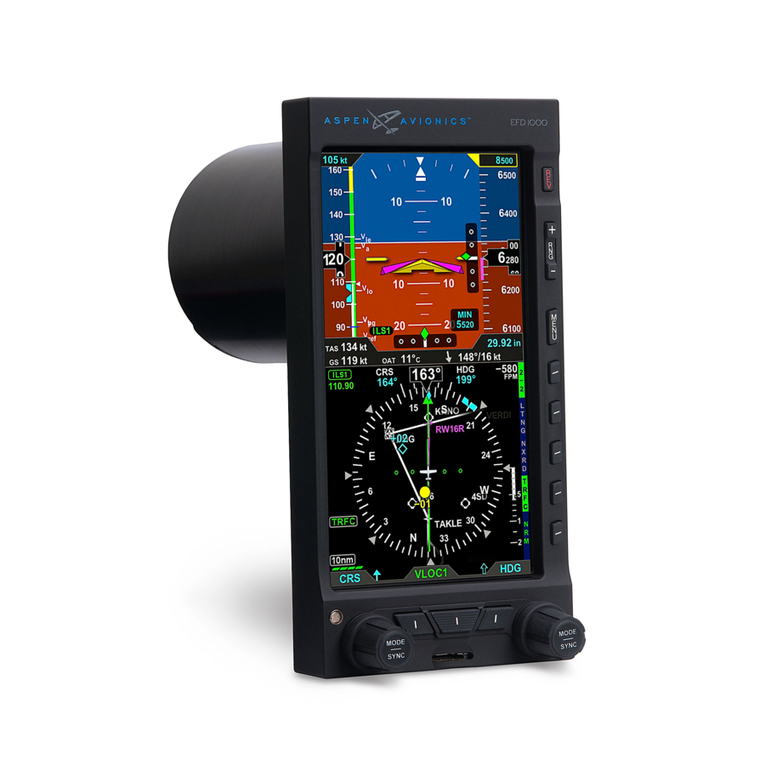
Aspen Avionics
Aspen Avionics Evolution 1000 Pro/VFR PFD pilot's guide
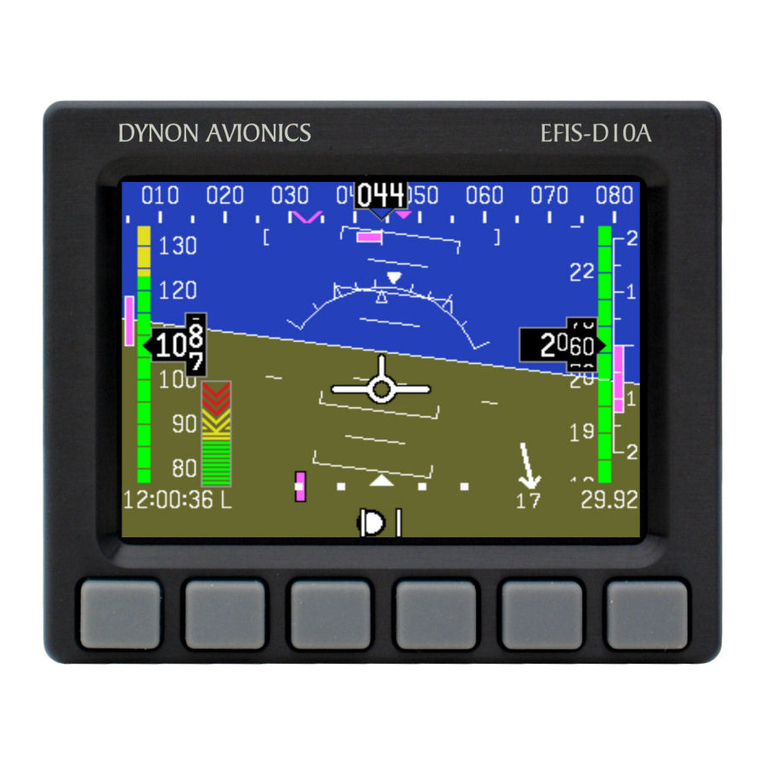
Dynon
Dynon EFIS-D10A installation guide
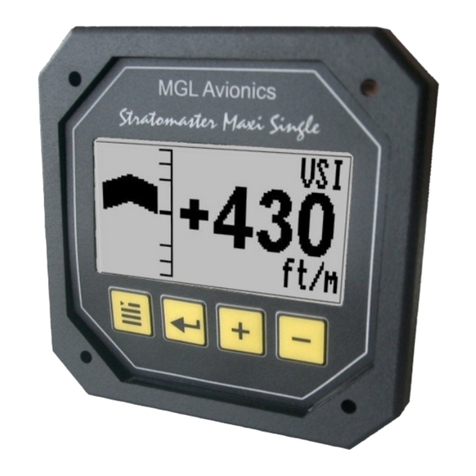
MGL Avionics
MGL Avionics Stratomaster Maxi Single VSI-2 instructions
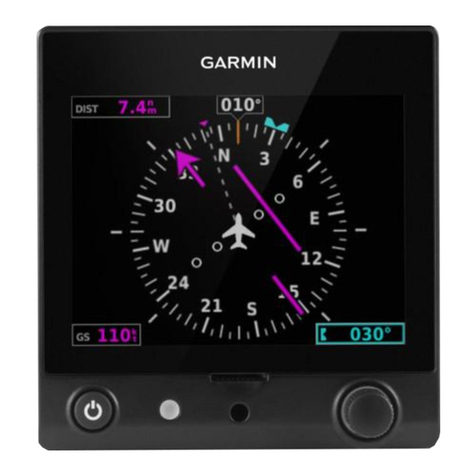
Garmin
Garmin Approach G5 - GPS-Enabled Golf Handheld Install manual & pilot's guide

Honeywell
Honeywell Bendix/King KTA970 pilot's guide
